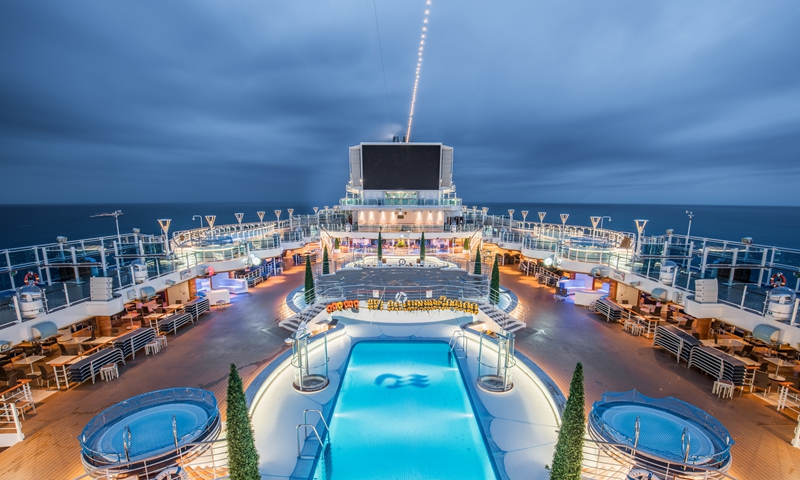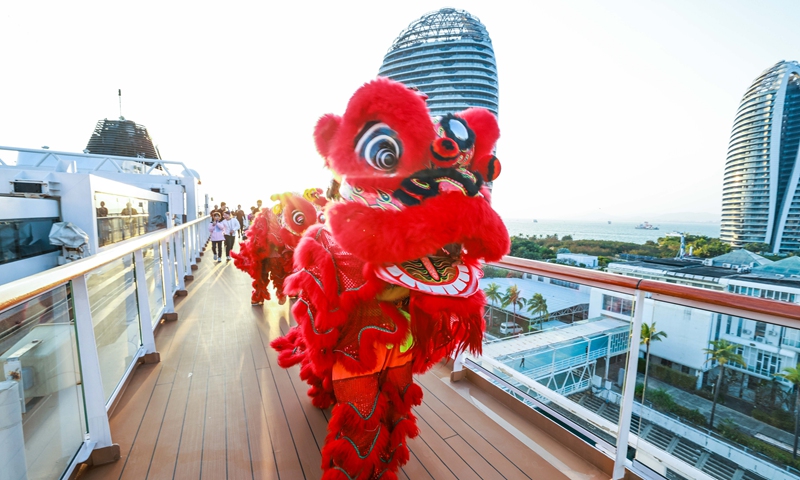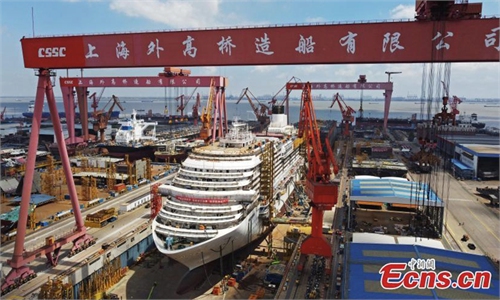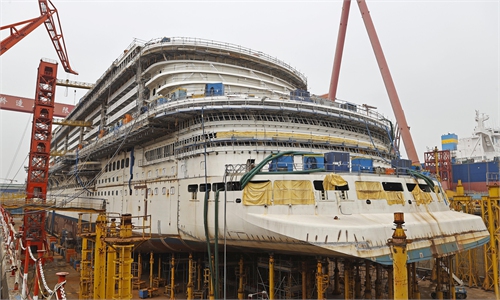Global cruise companies look for earliest reentry into China's market
Insiders mulling restart of an $81.05 billion business

An interior view of a luxury cruise liner Photo: VCG
With China reopening its borders and the gradual recovery of cross-border travel, those in the cruise industry market say they are taking a hopeful look into the earliest possible reopening of China's cruise market, which was the world's second-largest before the COVID pandemic struck.
Whereas the nightmare of those on board the Diamond Princess at the Yokohama Port in Japan, in which nearly 700 cases of infection were confirmed out of a total of 3,700 passengers and crew, became the epitome of the earliest days of the COVID pandemic, the global industry entered a recovery track in 2022.
Even Japan resumed its international cruise trips last week.
On January 31, the cruise ship Nippon Maru returned from Singapore to Yokohama, resuming a business that has been suspended for three years.
With China's announcement of reopening its border and restarting cross-border tourism, industry insiders are looking at possible opportunities to restart the business in China, a market that was the second largest globally in 2019.
"It was exactly around this time of the year three years ago that industry players decided to press the pause button, even before the situation aboard the Diamond Princess became a media highlight," Liu Zinan, Asia chairman of Royal Caribbean Cruise, recalled.
China's cruise industry has seen a golden period of growth in the decade before the COVID pandemic struck the global tourism industry.
In 2019, China's international cruise market was already 10 times that of Japan, only surpassed by the US which is the world's largest cruise market.
The Wusongkou International Cruise Port in Shanghai is Asia's largest, and one of the world's top four largest ports for cruise ships.
From 2006 to 2019, foreign cruise brands deployed a total of 23 cruise ships to China, spending 3.6 billion yuan ($530 million) a year on marketing, as the Chinese market grew at a staggering annual rate of 52 percent.
Since China downgraded the management of COVID-19 to Class B on January 8, the tourism sector has since embarked on a gradual recovery track.
On Monday, several tour groups made their debut since the outbreak of the epidemic in 2020 as China officially restarted cross-border group tour services. The initial batch of tours under a pilot program for group tours including flight and hotel services was to 20 destination countries.
The clamor in other tourism sub-sectors has certainly been a morale boost for the cruise business and market entrants including the Royal Caribbean who had been calling for an earlier resumption of cross-border cruise services, which by definition include port calls to at least one foreign port.
"Now we can almost see the prospect of resumption of this industry slowing emerging on the horizon," Liu told the Global Times.
With the State Council, China's cabinet, having issued a policy calling for a piloted resumption of the cruise market, Liu revealed that the industry and local government authorities are exchanging views regularly with many meetings to discuss details regarding the earliest possible reopening of the international cruise business.
"The trend of restarting the sector is already very clear. The move to ease relevant policy curbs needs to be fast as the industry can't afford any more delays, as the Northeast Asian market is already lagging by two years compared with the US and the Europe markets," Liu said.
According to the industry portal Cruise Industry News, as of October 2022, some 93 percent of the global cruise fleet was back in service.
As the cruise business has an exceedingly long upstream and downstream supplier industrial chain, it will still take months once the industry gets a policy nod before the first cruise ship can set sail, Liu said, predicting that the industry could be reopened toward the end of this year or in 2024.
A different approach
While many big international cruise companies left China in the last three years when outbound cruise operations were suspended, there were also companies that took a different approach.
Brendan Tansey, managing director of Viking Cruises China, told the Global Times that throughout 2022, the company shifted its focus to domestic ocean cruise products, resulting in the launch of the company's China Coastal Cultural Cruises - a domestic luxury ocean cruise product - on October 1, 2021. It is the only premium ocean cruise still operational in the Chinese market to date. Over 75 successful cruises have so far been completed by the company's ship CM-Yidun, a ship under a joint venture between Viking Cruises and China Merchants Shekou.

Guests follow a troupe of lion dance performers on CM-Yidun during its Spring Festival cruise in Sanya, South China's Hainan Province on January 20, 2023. Photo: courtesy of Viking Cruises
Tansey said the global cruise industry in most markets around the world has recovered, and has seen a very encouraging comeback with pent-up travel demand driving up passenger numbers. For Viking Cruises, bookings for both river and ocean itineraries for English-speaking markets outside of China have returned to pre-pandemic levels."We are receiving more inquiries about our cruises, and passenger numbers for our existing domestic ocean product are slowly picking up. But we can see that guests are really keen on outbound itineraries based on the inquiries we receive," Tansey said, noting the company's confidence in the Chinese cruise market's huge growth potential.
Tansey said Viking believes Chinese consumers are interested in cruise travel, but whether the growth falls on domestic or outbound cruises depends to a large extent on issues including whether the local policy is conducive to actual operations.
"We will continue to operate our domestic ocean cruises, while making sure we remain flexible to pivot to outbound itineraries if demand and travel policies both in China and at the target destinations present ripe opportunities," Tansey said.
Cruise and beyond
Industry experts said cruise tourism is also subject to certain geopolitics risks.
In one instance in 2017, when China and South Korea clashed over the deployment of the Terminal High Altitude Area Defense (THAAD) system, over 3,400 Chinese tour travelers refused to disembark from their cruise ship at South Korea's Jeju Island, grabbing media attention.
Developing the cruise industry also brings a series of benefits for China to improve the quality of its shipbuilding industry, help related suppliers upgrade their products, and further improve China's business environment, they noted.
The promising Chinese market has shown its potential to industry players in the decade prior to the pandemic, it's now high time to allow the market to return back to its Golden Age course, the Royal Caribbean's Liu said.
According to a report by the China Cruise & Yacht Industry Association and the Shanghai Academy of Social Sciences, the cruise ship industry could contribute a total of 550 billion yuan ($81.05 billion) in economic output to the Chinese economy by 2035. About 15 percent of them would come from the building of new ships, repairs, and maintenance.



